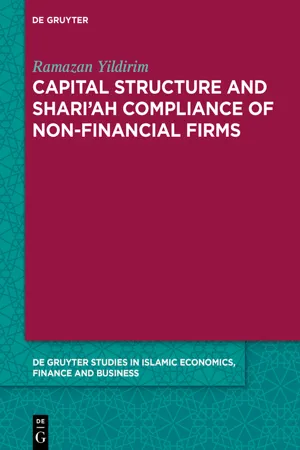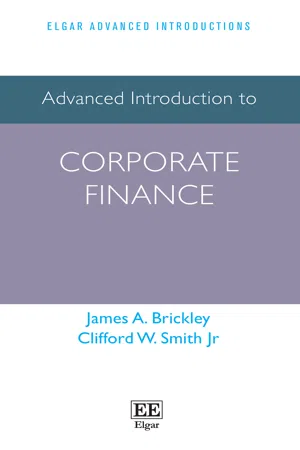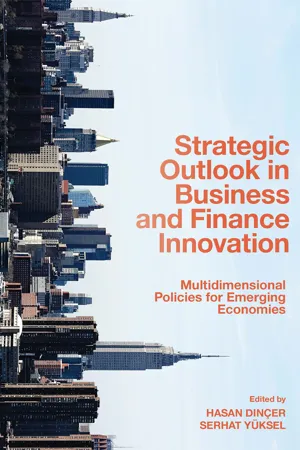Business
Pecking Order Theory
The Pecking Order Theory in business refers to the concept that companies prefer to use internal financing rather than external financing, and when external financing is necessary, they prefer debt over equity. This theory suggests that firms have a hierarchy of financing sources, with retained earnings being the most preferred, followed by debt, and then equity as a last resort.
Written by Perlego with AI-assistance
Related key terms
1 of 5
7 Key excerpts on "Pecking Order Theory"
- eBook - PDF
- P. Molyneux(Author)
- 2011(Publication Date)
- Palgrave Macmillan(Publisher)
Taking this into considera- tion, the trade-off theory has only one opposing challenger; the Pecking Order Theory . The Pecking Order Theory originates from the early empirical work of Donaldson (1961) and is founded on observations of managerial finan- cial decision-making in practice. Myers (1984) coined the term ‘pecking order’ when conceptualizing the theory into an asymmetric information setting where managerial incentives are perfectly aligned with the over- all objective of maximizing shareholder value for the current owners. This theory does not acknowledge any optimal capital structure within firms. A firm’s actual capital structure is seen as the aggregated result of successive financial decisions made by managers. In conditions of asym- metric information between insiders and outsiders, the Pecking Order Theory concludes that the implicit alliance between management and the current shareholders makes it costly for the firm to attract new inves- tors; the lower the priority of a new security, the higher its cost. This creates a rank between different securities, where those with highest pri- ority are ranked before securities with a lower priority. Following this logic, management’s first choice is internally generated funds. Thereafter attention is directed to various forms of debt in a ranking order with respect to priority. In this pecking order new equity is regarded as a last resort. It should be noted that, because of asymmetric information, debt is preferred to equity even without corporate taxes. Managers’ Capital Structure Decisions 275 In this chapter the aim is to test the explanatory power of the Pecking Order Theory on the financial decisions in large Swedish firms. It also explores how these decisions relate to the trade- off theory in its static and extended forms. The results are compared to the findings of Graham and Harvey (2001) and Beattie et al. - Ramazan Yildirim(Author)
- 2021(Publication Date)
- De Gruyter(Publisher)
45Above, we have shown mixed findings of the validity of the Pecking Order Theory. This accounts for the main problems derived from the asymmetric information among the different stakeholders, i.e., adverse selection or moral hazard.462.4.3 Critical Comments on Pecking Order Theory
As mentioned above, the agency theory tries to find a mixture of debt and equity financing to mitigate such agency costs. In contrast, the Pecking Order Theory rationale does not arise from a given capital structure, but rather from asymmetric information between managers (insider) and potential investors (outsider).Pecking Order Theory rejects the idea of a firm’s optimal target capital structure. It suggests a flexible approach in which firms can consider structuring their capital at any point in time. In the words of Myers (2001 , p. 93), “Each firm’s debt ratio[,] therefore reflects its cumulative requirement for external financing.” This indicates that the number of investment opportunities with positive NPV and the available cash and securities dictates the capital structure. Consequently, profitable firms with only a few investment opportunities have no benefit of issuing debt, thus keep their leverage ratio low. The more profitable a firm, the more internal funds, aka cash, can be generated. Upcoming investment opportunities can be financed internally that consequently keep their leverage ratio low. Firms with the limited use of external financing can maintain “financial flexibility”, which is considered one of the most important capital structure determinants, according to Graham and Harvey (2001) study. Empirical studies have shown the firm’s preferences for internal financing compared to equity as external financing.47- eBook - PDF
- James A. Brickley, Clifford W. Smith Jr, James A. Brickley, Clifford W. Smith Jr(Authors)
- 2022(Publication Date)
- Edward Elgar Publishing(Publisher)
The Pecking Order Theory argues that managers have a strict preference for internal over external financing and debt over equity financing when the firm has to raise funds externally. Under versions of this theory, firms do not have target capital structures – observed capital structures are simply the result of past investment requirements and financing history. Within this chapter we reviewed the collective evidence from large-sample panel studies that are directed at testing alternative capital structure theo- ries. The results from these studies do not support the most basic tradeoff models which hold investment policy fixed. They report little evidence of an important role for direct bankruptcy costs, consistent with expected direct costs of bankruptcy being quite small for most public corporations. And there is comparably little evidence that the firm’s current marginal tax rate is a major determinant of a firm’s capital structure. The collective evidence provides reasonably strong support for versions of tradeoff models that focus on the indirect costs of financial dis- tress, including the Underinvestment Problem and the Free Cash-Flow (Overinvestment) Problem. Leverage appears to be significantly and negatively related to the firm’s market-to-book ratio, a widely employed proxy for the firm’s growth opportunities. According to the Tradeoff Theory, growth firms will use less debt in their capital structures because of greater concerns about the indirect costs of financial distress, particu- larly the Underinvestment Problem. At the same time, they gain fewer benefits from using debt to address the Overinvestment Problem, which by definition occurs primarily in low-growth “value” firms. The observed DETERMINANTS OF LEVERAGE 87 positive association between leverage and the tangibility of assets, firm size, and regulatory status, provide additional support for the Tradeoff Theory. - eBook - ePub
Strategic Outlook in Business and Finance Innovation
Multidimensional Policies for Emerging Economies
- Hasan Dinçer, Serhat Yüksel, Hasan Dinçer, Serhat Yüksel(Authors)
- 2021(Publication Date)
- Emerald Publishing Limited(Publisher)
Myers (2001 ) argues that the fact that interest on debt is deducted before tax payment, the use of debt provides benefit to the firm in the form of tax shield. However, increasing use of debt magnifies firms’ default tendencies on interest payment which may lead to bankruptcy. Therefore, the trade-off theory advocates for an optimal capital structure with the level of debt that reduces bankruptcy risk while maximizing the benefits for debt finance. In addition to bankruptcy costs, agency costs may also arise from the increasing use of debt emanating from the decisions some debt suppliers inaugurate. Firm debtors may put in place measures such as restrictive covenants to protect their funds.The Pecking Order Theory advocated by Myers and Majluf (1984 ) alternates the trade-off theory. The basic assumption of this hypothesis is that firms do not seek to minimize cost of capital, instead, they pursue additional finance in preferential order. In sourcing finance, firms will first resort to retained earnings and then will favor debt usage over equity financing. Firms consider the issue of new equities as the last financing tool.Empirically, the debate on the theory that broadly explains firms financing decisions is yet to be settled in the capital structure literature. Following the theoretical arguments, numerous studies have probed into the factors influencing capital structure. For instance, Huang and Song (2006 ) conducted an empirical analysis on the factors determining Chinese firms’ capital structure for the period 1994–2003. Applying the ordinary least squares (OLS) method on data of 1,200 firms, they evidenced that profitability, growth opportunities, managerial ownership, and tax significantly negatively determine firms’ total debt. The results also showed that asset tangibility positively and significantly influences the debt level of Chinese firms.Using manufacturing firms with data spanning 2003–2007, Sheikh and Wang (2011 ) analyze how firm-level characteristics can potentially drive capital structure decisions in Pakistan. From the analysis, the results show that firms’ capital structure decisions are motivated by profitability level, the size of firms and the asset tangibility, earnings volatility, and firms’ liquidity level. Abdeljawad, Mat-Nor, Ibrahim, and Abdul-Rahim (2013 - eBook - ePub
- Anton Miglo(Author)
- 2016(Publication Date)
- Palgrave Macmillan(Publisher)
The authors argue that these results are consistent with the debt capacity in the pecking order model. De Jong, Verbeek, and Verwijmeren (2011) test the static trade-off theory prediction that a firm increases leverage until it reaches its target debt ratio, and the prediction of POT that debt is issued until the debt capacity is reached. It is found that POT is a better descriptor of firms’ issue decisions than the static trade-off theory. Dong et al. (2012) study market timing and pecking order in a sample of debt and equity issues and share repurchases of Canadian firms from 1998 to 2007. They find that only when firms are not overvalued do they prefer debt to equity financing. Saumitra (2012) tests POT for an emerging economy through a case study of the Indian corporate sector that includes 556 manufacturing firms over the period 1997–2007. The study finds strong evidence in favor of the pecking order hypothesis. Bhama et al. (2015) examine firms (in India and China) with normal as well as large deficits and surpluses. The study finds that Indian and Chinese firms frequently issue debt when they have normal deficits. The pecking order results are less supportive for Indian firms with large deficits. Mogilevsky and Murgulov (2012) examine underpricing of private equity backed IPOs listed on a major US stock exchange between January 2000 and December 2009. The authors identify 265 private equity backed IPOs and compare these with concurrently listed venture capital (VC) backed and non-sponsored IPOs. The results indicate that, on average, private equity backed IPOs experience a significantly lower level of underpricing than venture capital backed and non-sponsored IPOs. 3.4 When Incumbent Shareholders Are Risk -Averse In traditional pecking order models, like the one discussed in the previous section, good quality firms are forced to use internal funds if available to avoid adverse selection problems and a loss in value - Hans Landström(Author)
- 2017(Publication Date)
- Edward Elgar Publishing(Publisher)
Among the studies, several provide confirmatory evidence of the POF (López-Gracia and Sogorb-Mira, 90 ADVANCED INTRODUCTION TO ENTREPRENEURIAL FINANCE 2008; Mac an Bhaird and Lucey, 2011; Sogorb-Mira, 2005). However, the characteristics of entrepreneurial ventures are quite different from those of large and mature companies and over time there have been changes in the choices and costs of external finance (Howorth, 2001; Paul et al., 2007); thus it is not immediately obvious that the ideas behind the POF are fully applicable in entrepreneurial ventures, or the pecking order might be somewhat modified in the context of entre- preneurial ventures. Empirical studies have indicated that a variety of pecking orders exist (Atherton, 2009): ● Howorth (2001) shows that in small firms the POF only operates in a truncated form, where truncation in many cases occurs at the point of long-term debt; that is, due to the wish for independence and control many entrepreneurs will not consider using external equity, leading to a truncated pecking order. ● Paul et al. (2007; see also Grichnik et al., 2007) argue that the POF is constrained for young firms leading to a ‘bridged’ pecking order where certain forms of finance are avoided or not considered. Paul and colleagues found that entrepreneurs in new ventures first and foremost use internal sources – their own funds – how- ever, when external funds are required, the main source seems to be equity rather than debt. Therefore, they argued for a ‘bridged pecking order’ in that businesses moved from self-funding to external equity instead of bank finance. The reason might be that debt is regarded by the entrepreneur as a personal liability (often bank debt needs to be underwritten by personal guarantees) and entrepreneurs place a self-imposed limit on the extent to which they want to mortgage their assets, and additionally, entrepreneurs seek equity in order to obtain added value – business skills and networks.- eBook - ePub
Tourism, Hospitality and Digital Transformation
Strategic Management Aspects
- Kayhan Tajeddini, Vanessa Ratten, Thorsten Merkle, Kayhan Tajeddini, Vanessa Ratten, Thorsten Merkle(Authors)
- 2019(Publication Date)
- Routledge(Publisher)
6THE APPLICATION OF THEORIES ABOUT CAPITAL STRUCTURE
Pecking order, trade-off and signaling in the hotel units in Portugal
Aida Maria de Brito Martins, Joaquim Carlos da Costa Pinho and Graça Maria do Carmo Azevedo6.1 Introduction
Decisions about the components of the capital structure, that is, how companies use their own and other capital to finance their assets, are critical to companies (Couto & Ferreira, 2010; Singh et al., 2014). Over the last few decades, several theories on capital structure have been developed, notably Trade-off (Kraus & Litzenberger, 1973; Scott, 1977; Kim, 1978), Pecking order (Myers, 1984) and Signaling (Leland & Pyle, 1977; Ross, 1977). According to the Trade-off theory, the companies aim to achieve an optimal level of debt, which takes into account the combination between tax benefits of debt and the costs of insolvency of the company, whereas for the theory Pecking order the changes in debt are a consequence of the financial needs of companies, which must exhaust domestic sources of financing first, followed by indebtedness and only in the last option the issuance of capital abroad. Signaling theory is based on the asymmetry of information between two parties (Connelly et al., 2011) and argues that the value of securities issued by companies will depend on how investors will interpret financial decisions as evidence of future corporate income streams; higher levels of debt issuance may be interpreted as positive signs.The various studies carried out on the capital structure of companies have concluded that this is related to some business characteristics. These studies have been applied to different sectors of business activity in different countries, and the results obtained have been divergent (Titman & Wessels, 1988; Couto & Ferreira, 2010; Serrasqueiro & Nunes, 2012; Wellalage & Locke, 2013; Kühnhausen & Stieber, 2014; De Luca, 2015; Serrasqueiro & Caetano, 2015; Panagiotis, 2016).
Index pages curate the most relevant extracts from our library of academic textbooks. They’ve been created using an in-house natural language model (NLM), each adding context and meaning to key research topics.






